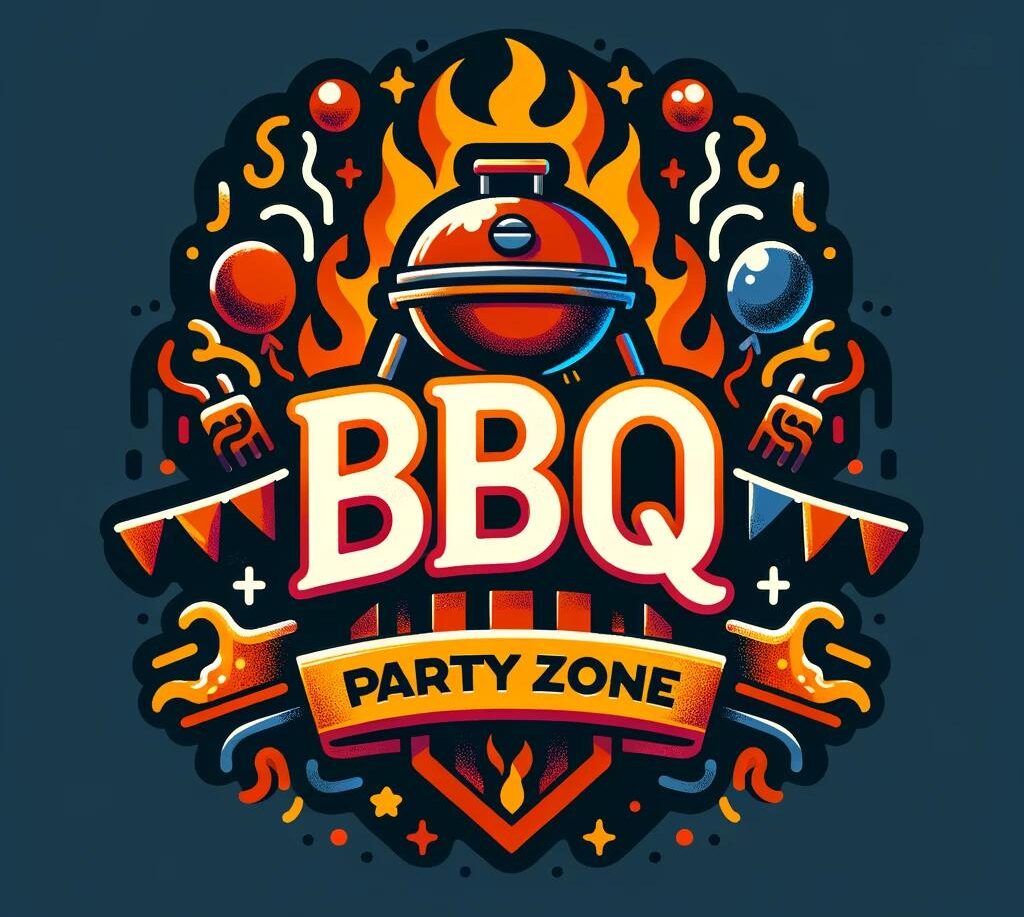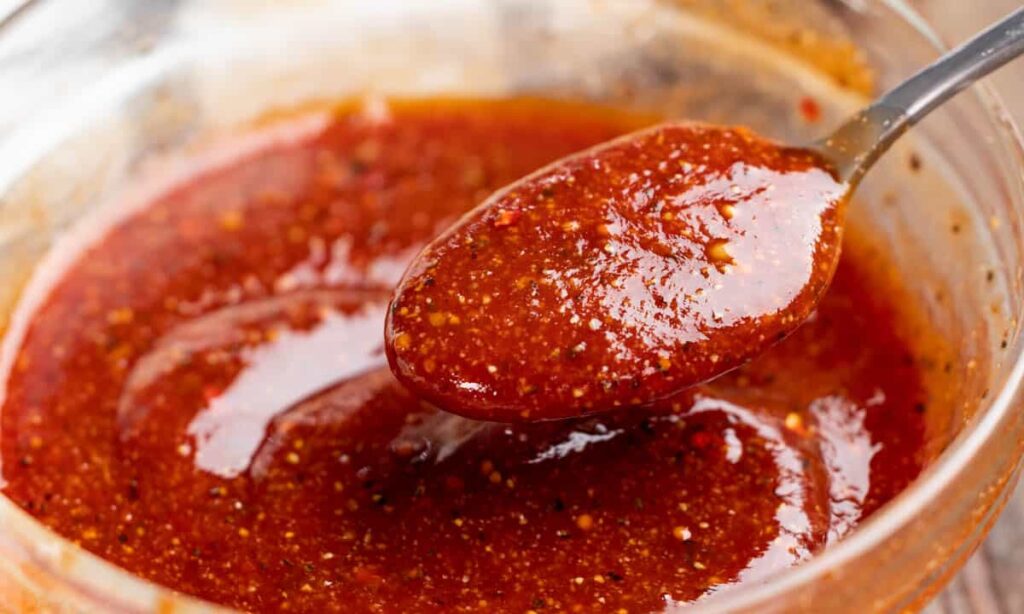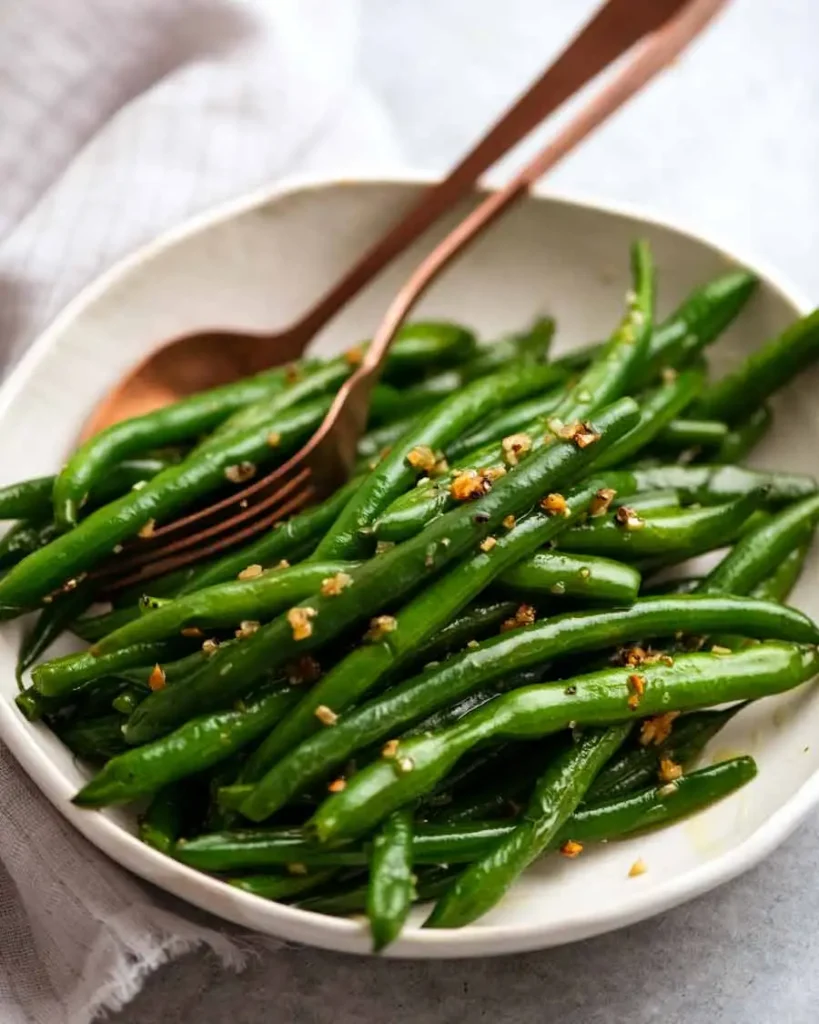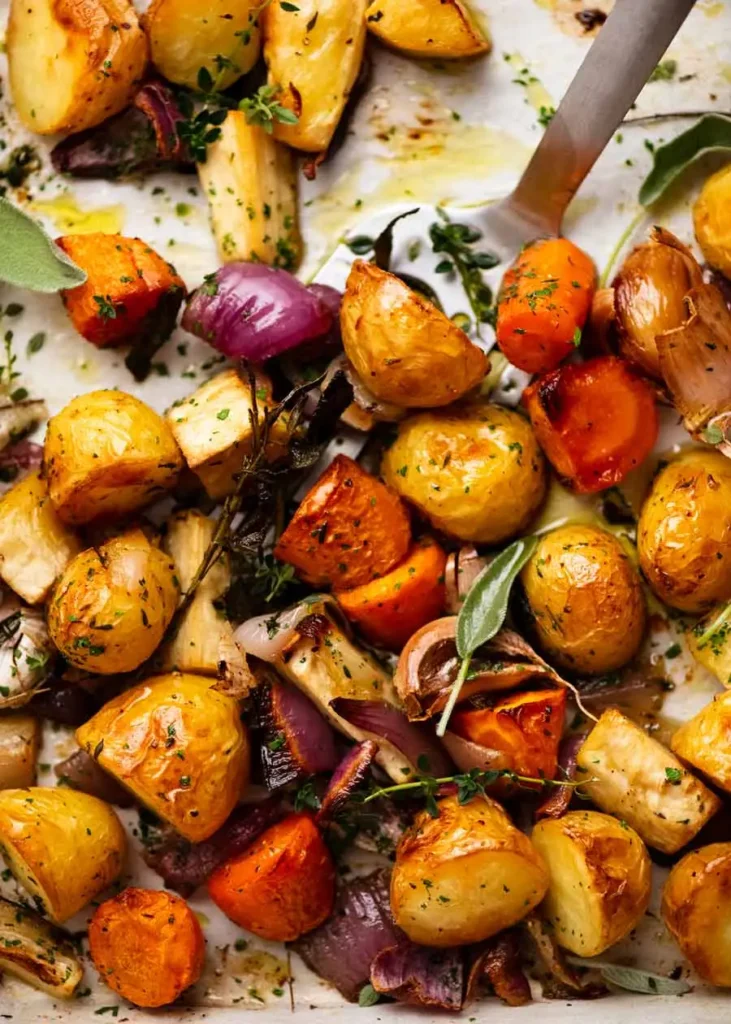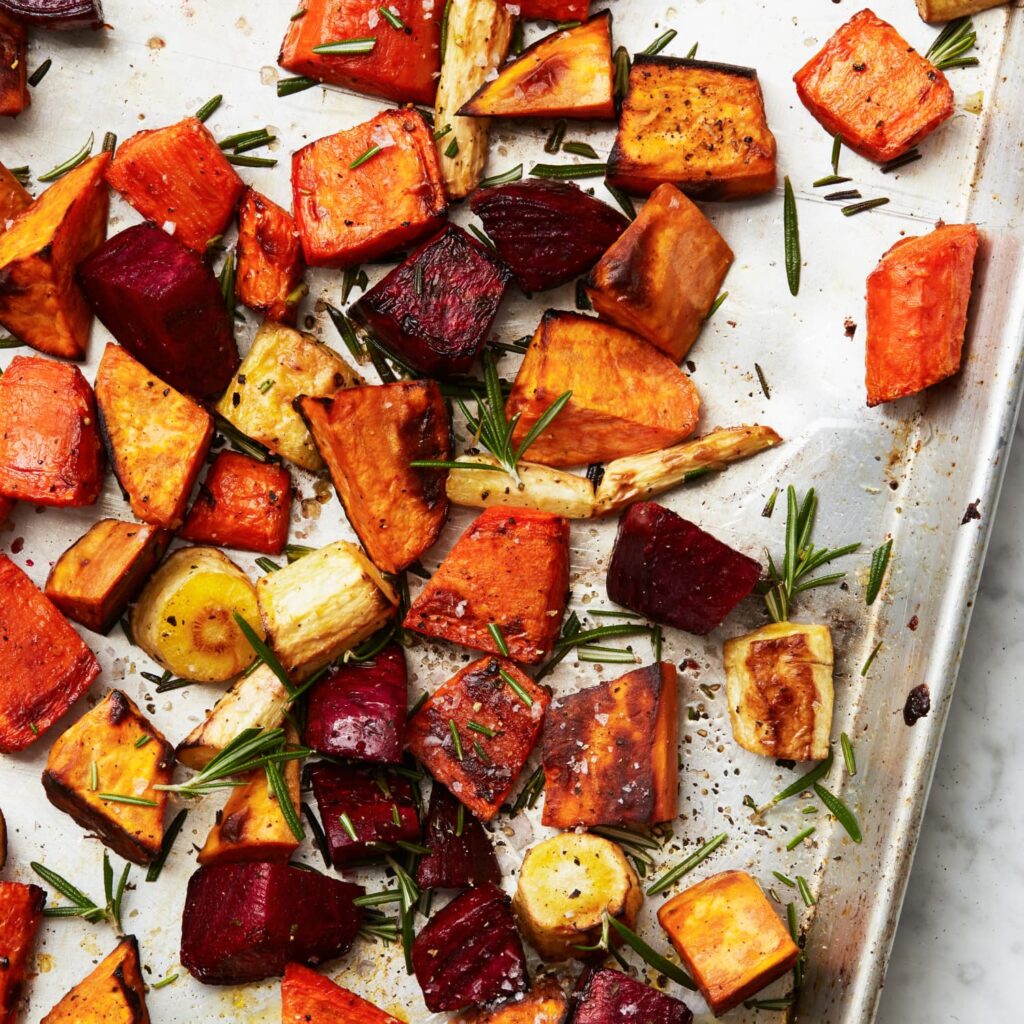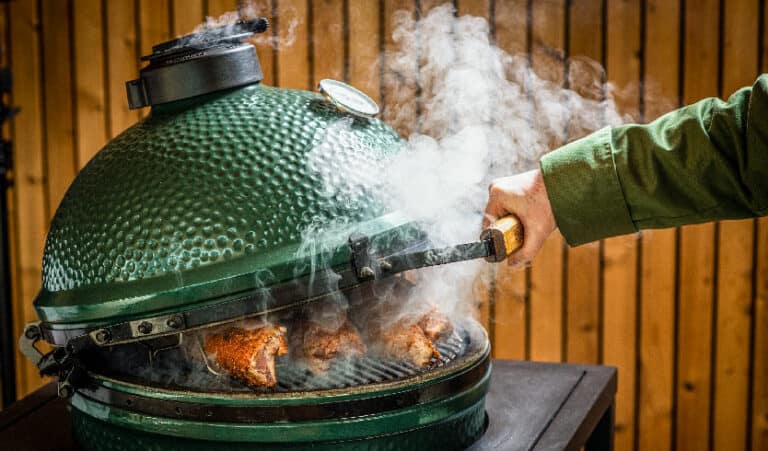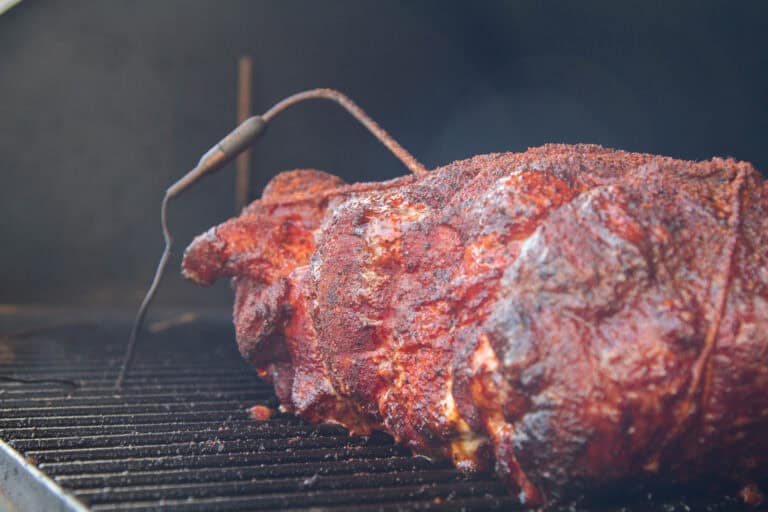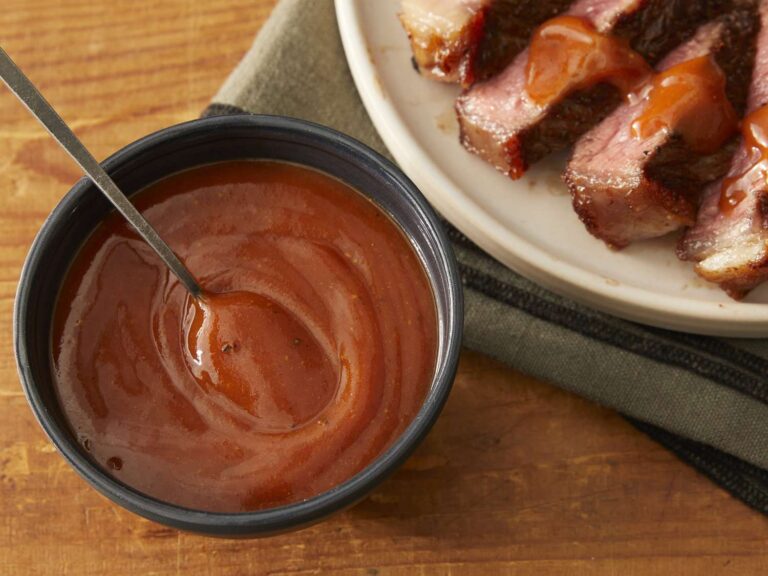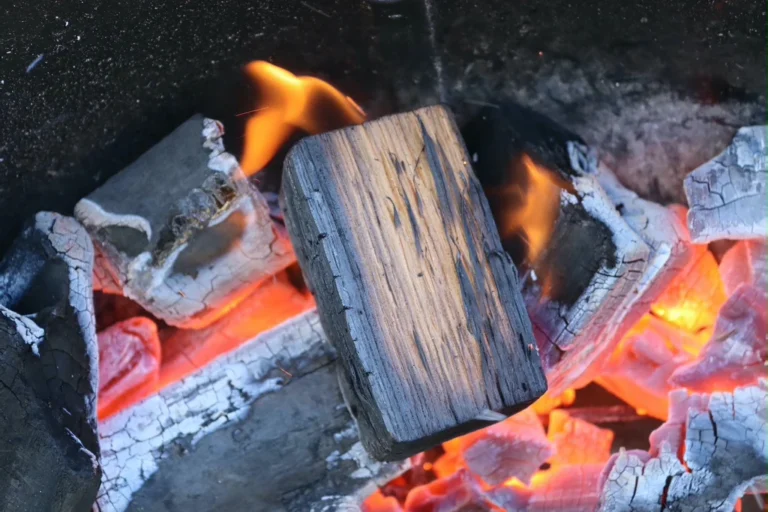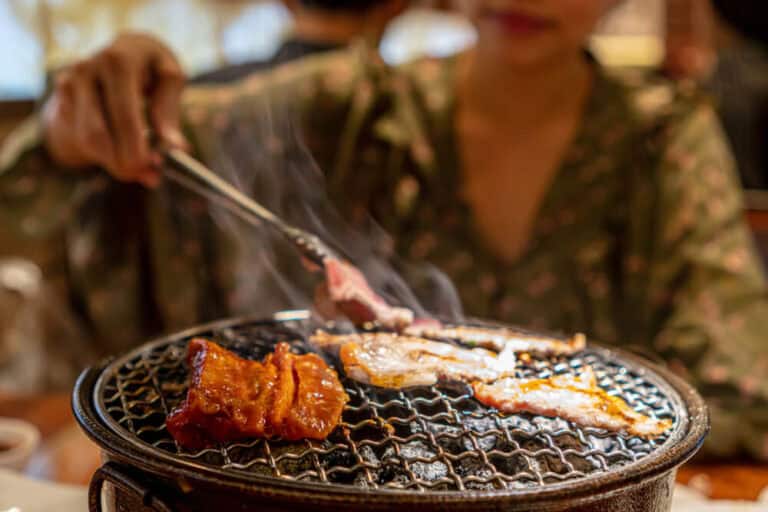How to BBQ a Whole Salmon in 5 Easy Steps
Ever thought about leveling up your BBQ game with something that’s not just another burger or hot dog? Let’s dive into the world of How to BBQ a Whole Salmon, a show-stopping centerpiece that’s bound to impress. We’re talking about transforming your backyard BBQ into a gourmet feast with just a fish (yeah, a whole one) and your trusty grill.
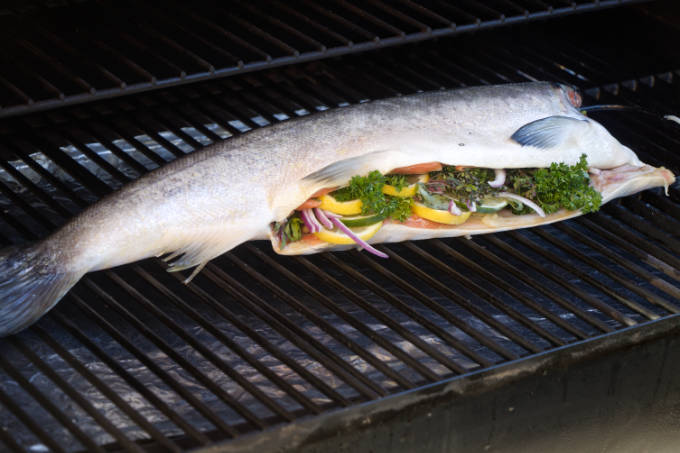
Get ready to unleash the smoky, succulent flavors of the sea right on your plate. So, grab your apron, and let’s make BBQ magic happen with a whole salmon. Ready to be the grill master you were born to be? Let’s roll!
Do You Skin Salmon Before Grilling?
To skin or not to skin the salmon before grilling? Well, let me break it down for you in the most straightforward way—keep that skin on! Here’s why:
- Protection: The skin acts like a protective barrier between the salmon’s delicate flesh and the fiery grill. It’s like the salmon’s own personal knight in shining armor, warding off direct flames and preventing the meat from sticking to the grill.
- Moisture Keeper: Skin helps lock in moisture, ensuring your salmon doesn’t dry out and turn into a sad, tough piece of fish jerky. We’re aiming for juicy, flaky perfection here, folks.
- Easy Flipping: Ever tried flipping a piece of skinless fish on the grill, and it just falls apart like it’s doing its best impression of a crumbling empire? The skin keeps your salmon intact, making it easier to flip and move around without turning it into a culinary disaster.
- Crispy Delight: When grilled right, the skin can crisp up into a deliciously crunchy treat. It’s like the fish version of a potato chip but healthier and packed with flavor. Trust me, even if you’re not a fan of eating fish skin, you might find yourself converted after trying it crispy.
How to How to BBQ a Whole Salmon
Grilling a whole salmon is like embarking on a culinary adventure—it’s easier than it looks and the results are incredibly rewarding. Here’s your step-by-step guide to grilling whole salmon, ensuring a feast that’s as impressive as it is delicious.
Step 1: Prepare the Salmon
- Clean and Gut: Start with a whole salmon that’s been cleaned and gutted. Rinse it under cold water, inside and out, then pat dry with paper towels.
- Score the Skin: Make shallow diagonal cuts across the skin, about an inch apart. This helps the heat penetrate evenly and allows flavors to seep in.

Step 2: Season Generously
- Inside Out: Season the cavity generously with salt, pepper, and your choice of herbs (dill, parsley, and thyme work well). You can also add slices of lemon, onion, or garlic for extra flavor.
- Oil Up: Lightly brush the outside of the salmon with oil to prevent sticking and to help the skin crisp up.
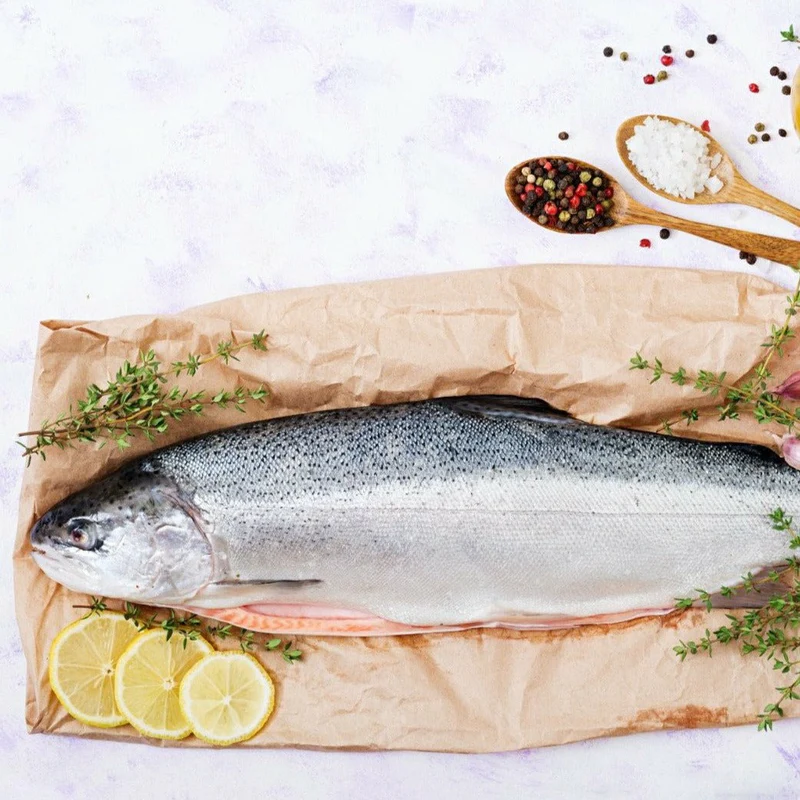
Step 3: Prep the Grill
- Heat Up: Preheat your grill to medium-high heat, around 375°F to 400°F.
- Clean and Oil: Make sure the grill grates are clean. Brush them with oil to prevent the salmon from sticking.

Step 4: Grill the Salmon
- Skin Side Down: Lay the salmon on the grill, skin side down. If it’s too large, you may use a large piece of aluminum foil underneath for easier handling.
- Cover and Cook: Close the grill lid. Cook for about 10-15 minutes per inch of thickness of the salmon. There’s no need to flip it; just let it cook skin side down the whole time.
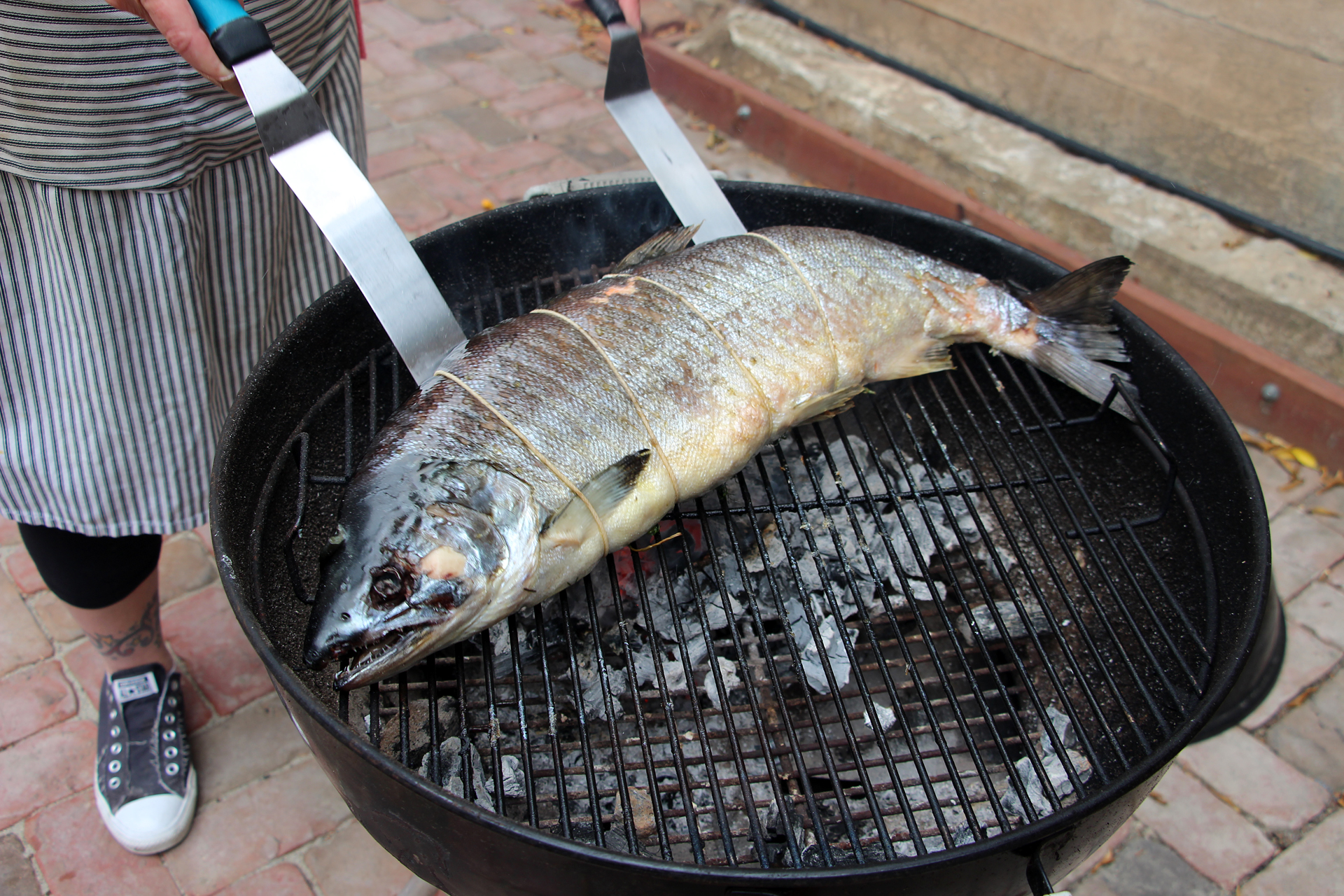
Step 5: Check for Doneness
- Look for Opacity: The salmon is done when the flesh turns opaque and flakes easily with a fork.
- Internal Temperature: For those who like precision, the internal temperature should reach 145°F when measured at the thickest part.
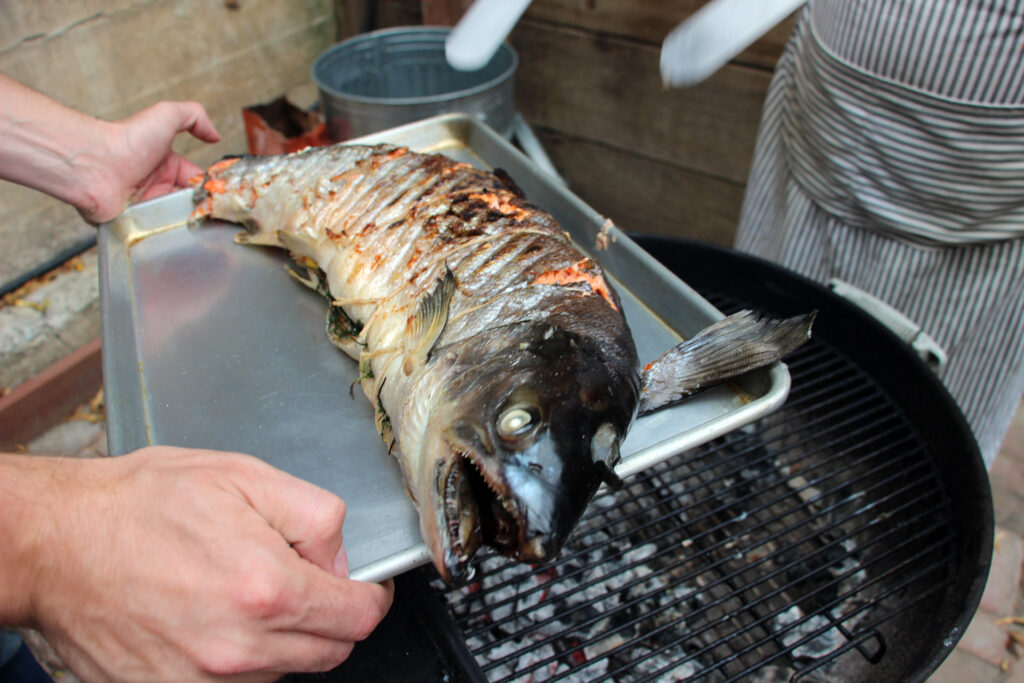
Step 6: Rest and Serve
- Let it Rest: Once done, gently remove the salmon from the grill and let it rest for a few minutes. This allows the juices to redistribute.
- Garnish and Enjoy: Transfer the salmon to a serving platter, garnish with fresh herbs and lemon wedils, and serve. It’s a showstopper that’s bound to impress.

Tips for Success:
- Gentle Handling: Use two spatulas for lifting the salmon off the grill to avoid breaking.
- Keep it Moist: If the salmon starts to look too dry while cooking, you can loosely cover it with foil.
- Experiment with Flavors: Feel free to get creative with the stuffing. Citrus, herbs, and spices can all contribute to the final flavor.
Grilling a whole salmon is a culinary feat that’s both impressive and delicious. This method of preparation infuses the fish with a smoky flavor that’s hard to beat, making it a perfect centerpiece for any gathering.
As for what to serve with this grilled masterpiece, a creamy dill sauce or a tangy lemon butter sauce would be fantastic, complementing the salmon’s richness beautifully.
For sides, consider light and refreshing options to balance the meal: a crisp green salad, garlic roasted potatoes, or grilled asparagus work wonderfully. These sides not only add a variety of textures and flavors but also enhance the overall dining experience, creating a well-rounded, satisfying meal that celebrates the natural, delicate flavors of the salmon.
What to Avoid When Cooking Salmon on the BBQ?
Cooking salmon on the BBQ is like a dance—a few missteps can turn a tango into a tangled mess. But fear not! Here are the pitfalls to avoid, ensuring your salmon grilling session is smooth sailing:
- Skipping Preheating: Not preheating your grill is like jumping into a pool without water—it just doesn’t work. A hot grill ensures the salmon cooks evenly and gets those gorgeous grill marks without sticking. Aim for medium-high heat and give it time to reach the right temperature.
- Leaving the Grill Dirty: A dirty grill is a no-go. Old bits of food and grime can stick to your salmon, making it difficult to flip and ruining its flavor. Give those grates a good scrub before you start.
- Forgetting to Oil: Even with a clean, hot grill, salmon can stick if you don’t oil the grates. A bit of oil on a paper towel, brushed over the grates, will do wonders. Also, oiling the salmon itself helps create a nice sear and prevents sticking.
- Overcooking: The most common tragedy in the salmon-grilling saga. Overcooked salmon is dry and lacks flavor. Remember, salmon should be removed from the grill just before it’s fully cooked, as it will continue to cook from residual heat.
- Not Using a Fish Basket or Foil: If flipping fish on the grill makes you nervous, a fish basket or foil can be your safety net. They prevent the salmon from falling apart or sticking, making your grilling experience a breeze.
- Ignoring Internal Temperature: Guesswork isn’t a chef’s tool. An instant-read thermometer takes the guesswork out of grilling, ensuring your salmon is perfectly cooked every time. Aim for an internal temperature of 145°F (63°C) at the thickest part.
- Flipping Too Early or Too Often: Give your salmon time to form a crust on the grill before flipping. Flipping it too early or too often can cause it to break apart or cook unevenly.
- Neglecting the Skin: Leaving the skin on protects the flesh and helps retain moisture. Plus, when crisped up right, it’s delicious. Just make sure to score the skin to prevent curling.
By steering clear of these common mistakes, you’re on your way to grilling salmon like a pro. Keep these tips in mind, and you’ll be serving up a dish that’s not just good, but grill-master level amazing.
How Do You Know When Salmon is Done on the BBQ?
Knowing when salmon is perfectly done on the grill is like hitting that sweet spot in a great song—everything just feels right. Here are a few tips to help you nail it every time, turning you into a salmon-grilling maestro:
- Look at the Color: As salmon cooks, it changes from a raw, translucent pink to a more opaque pinkish-white. When it’s done, the entire fillet should be opaque. If you’re seeing any transparent, sushi-like sections, it needs more time.
- Check the Texture: Gently press the top of the salmon with a fork or your finger. If the flesh flakes—meaning it separates easily along the white lines that run across the fillet—it’s ready for the plate. If it feels mushy or resists flaking, give it a bit more time.
- Peek Inside: The most foolproof method is to check the thickest part of the salmon. You can do this by inserting a fork or knife and gently pulling it apart. If the inside looks opaque and flakes easily, but still has a bit of a translucent, moist center, congrats, you’ve hit the jackpot.
- Use a Thermometer: If you’re like me and love a good gadget, a digital instant-read thermometer is your best friend. The ideal internal temperature for cooked salmon is 145°F (63°C). Insert the thermometer into the thickest part of the salmon to get a good read.
- Time is a Guideline: General wisdom suggests grilling salmon for about 6-8 minutes per inch of thickness, but remember, grills and salmon fillets vary. Use time as a guideline, not a rule set in stone.
What to Do with the Left Over Salmon?
Leftover salmon is like a versatile secret ingredient waiting to add a flavor punch to a variety of dishes. Here’s how to store it properly and some creative ways to reincarnate it into new, delicious meals:
Storing Leftover Salmon
- Cool Quickly: Allow the salmon to cool to room temperature as quickly as possible, but don’t leave it out for more than 2 hours to avoid bacteria growth.
- Refrigerate: Place the salmon in an airtight container or wrap it tightly in aluminum foil or plastic wrap. It’ll keep in the fridge for up to 3 days.
- Freeze for Longer Storage: For longer storage, wrap the salmon tightly in plastic wrap and then in aluminum foil. Store it in the freezer where it will keep for up to 3 months. Thaw in the refrigerator overnight when ready to use.
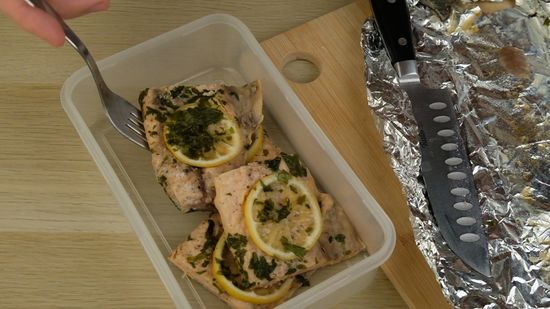
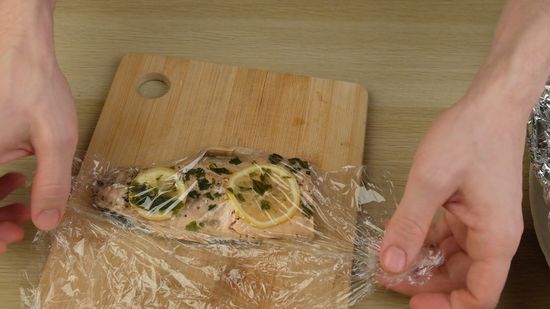
Creative Ways to Use Leftover Salmon
- Salmon Salad: Flake the salmon and mix it with a little mayo, diced celery, red onion, and capers for a delicious salmon salad. Serve it on toasted bread or mixed greens.
- Salmon Pasta: Toss flaked salmon into a creamy pasta sauce or a simple pasta with olive oil, garlic, and your favorite veggies. It’s a quick and satisfying meal.
- Salmon Fried Rice: Add flaked salmon to your fried rice towards the end of cooking. It adds protein and flavor to this classic dish.
- Salmon Omelette or Quiche: Mix flaked salmon into eggs for an omelette or quiche, along with some dill, cheese, and maybe a bit of cream cheese for a rich, flavorful breakfast or brunch option.
- Salmon Cakes: Combine flaked salmon with breadcrumbs, an egg, some herbs, and spices. Form into patties and pan-fry until crispy. Serve with a side of tartar sauce or aioli.
- Salmon Spread: Mix flaked salmon with cream cheese, lemon juice, dill, and seasonings to taste. Spread it on crackers, bagels, or cucumber slices for a quick snack or appetizer.
- Salmon Tacos: Flake the salmon and use it as the filling for tacos. Add some slaw, avocado, and a squeeze of lime for a fresh take on taco night.
Tips for Repurposing Salmon
- Gentle Reheating: If you need to reheat the salmon, do so gently to avoid drying it out. A low oven (275°F) covered with foil works well.
- Cold Dishes: Consider using the salmon cold in salads or spreads to preserve its moisture and flavor.
- Season Well: Leftover salmon can be a tad dry, so pair it with moist ingredients or sauces when reincorporating it into new dishes.

Leftover salmon offers a world of culinary possibilities, turning the next day’s meals into something everyone looks forward to. With a bit of creativity, you can transform leftovers into dishes that are as exciting as the original meal.
Conclusion
In wrapping up, grilling a whole salmon is an adventure that rewards you with a stunning, flavorful dish that’s bound to impress any crowd. From the initial selection and preparation of the fish to the final, mouth-watering presentation, each step brings its own joy and satisfaction. The accompanying creamy dill or lemon butter sauce, alongside sides like garlic roasted potatoes or grilled asparagus, elevates the meal into a harmonious blend of flavors and textures.
Don’t let leftovers go to waste; they can be transformed into delicious, innovative meals, ensuring that the majestic salmon is enjoyed to the last flake. Embrace the process, experiment with flavors, and most importantly, share the delicious results with friends and family. Grilling a whole salmon is more than just cooking; it’s an act of love, a celebration of good food, and the creation of lasting memories around the dining table.
